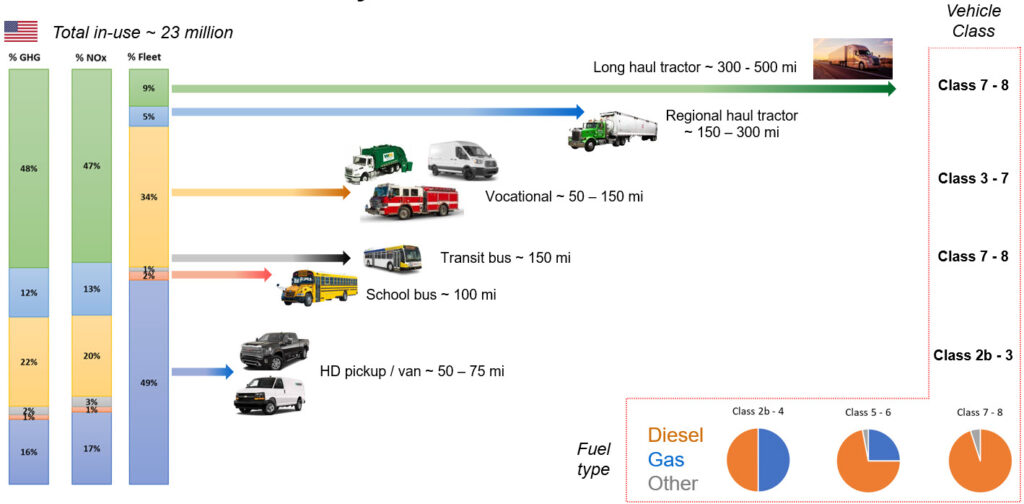Characterizing the in-use heavy-duty vehicle fleet
The heavy-duty on-road sector is facing multiple regulations – CO2 targets (30% reduction by 2030 in Europe), NOx and particulate reductions (90% reductions in California), and electrification mandates (albeit very nascent, including only California’s Advanced Clean Trucks regulation). These could be met through a range of new technologies – improving conventional engines and emissions control to full electrification. But the solution will unlikely be a one-size-fits-all given the diversity of the applications. This is hopefully the first in a series of articles that examines the diversity of the HD sector, with the ultimate goal of outlining enablers and barriers for a transition to electrification (including fuel cell vehicles). We start with a US-centric approach simply because of relatively easier access to data, but it is noted that Europe and China will play a very important role and will be lookied at in the future.
Here is a summary chart which explores some aspects of the in-use fleet in the US. A few key takeaways:
- Almost half of the fleet consists of pickup trucks and vans with a relatively small daily range of < 100 mi and return to a central location — arguable easier to electrify
- Long-haul trucks, on the other end are only 9% of the fleet but often go for days with up to 500 miles per day – arguably the most difficult to electrify
- Note however, that long-haul trucks emit almost half of the greenhouse gases and NOx (and particulates, not shown) – hence the need to continue to set tighter emissions standards for this segment.
- Buses get a lot of press with cities and airports moving towards electrics. Note that the fraction of fleet and the impact on environment is fairly small. Of course they also ply in urban areas the most so that reducing emissions is critical. (Note that we are not talking economics yet – total cost of ownership of buses and other vehicles will be discussed separately)

Also shown in the chart is the diversity in vehicle classes and the engines used for these applications today. Note that in the lighter segments there is significant penetration of gasoline vehicles, while the heaviest classes rely mostly on diesel, with some (< 5%) share for compressed natural gas engines.
The future makeup of heavy-duty transportation will depend on various factors – range and load carrying requirements, charging infrastructure and time, and ultimately total cost of ownership – for these are ultimately vehicles of profit for business owners. And the chart above shows that these factors will be very different for the various segments. More to come on them.
If you like such content, check out the monthly newsletter covering the latest on sustainable transportation technologies and regulations. Sign up below.
Like it ? Share it !
Other recent posts
How much biofuels can we make, really ?
Lowering the carbon footprint of existing vehicles will require switching to low carbon fuels. The immediate question this raises, is “how much low carbon fuel can we make?” and, “doesn’t using biomass for fuels affect the food production?”
Summary of EV related U.S. Tariffs on Chinese Imports
The Biden Administration has announced significant new tariffs on a range of Chinese-made electric vehicles and related strategic components. Here is a summary.
SAE WCX 2024 – Year in Review
The SAE World Congress was held in Detroit and covered a broad range of topics pertinent to transport decarbonization. Here’s a link to download presentations on emissions and sustainability.
